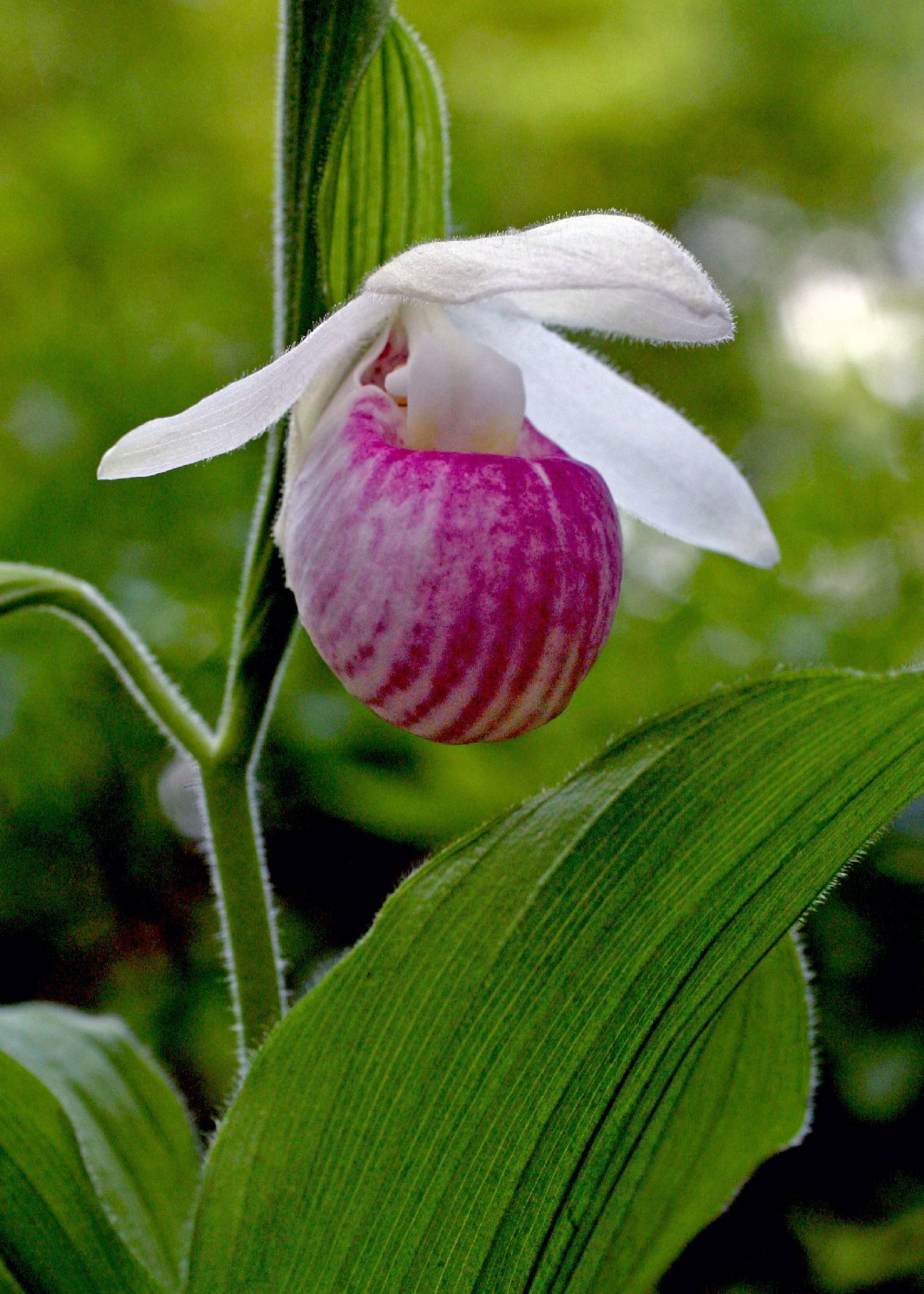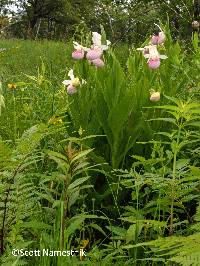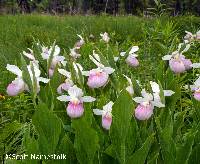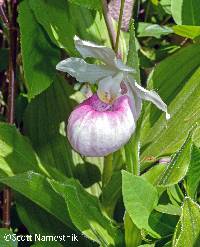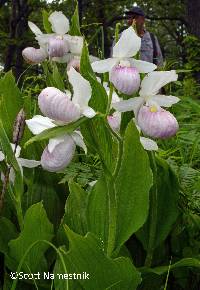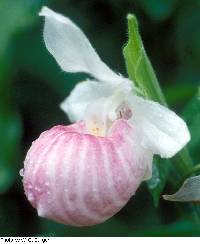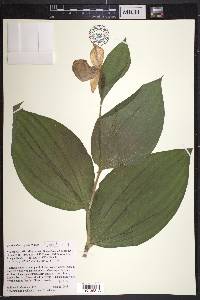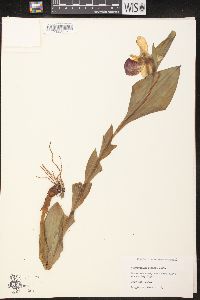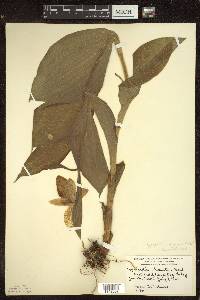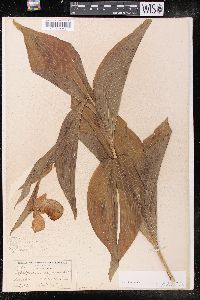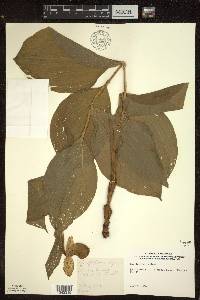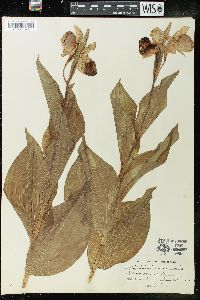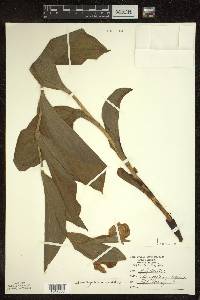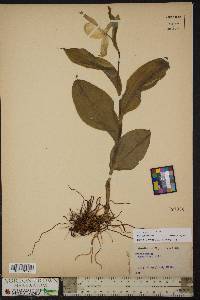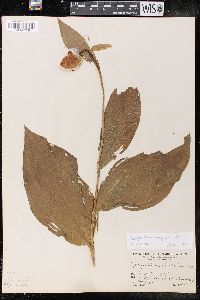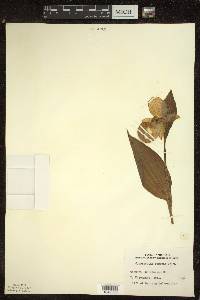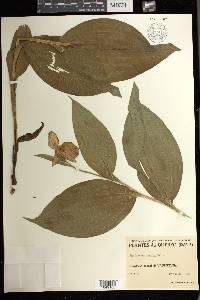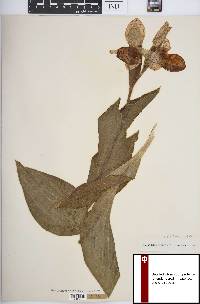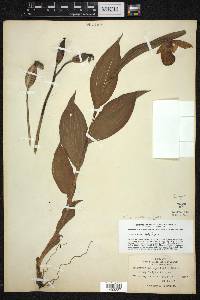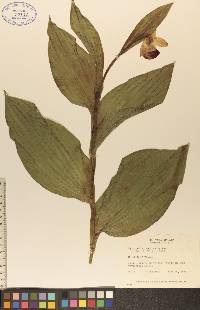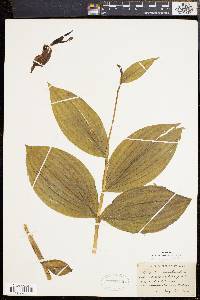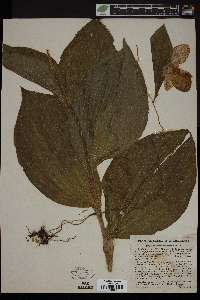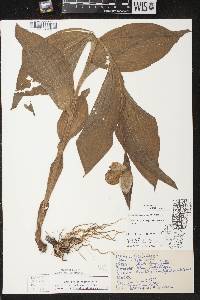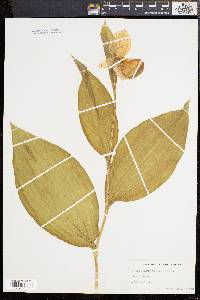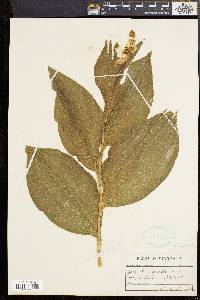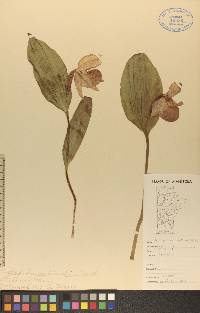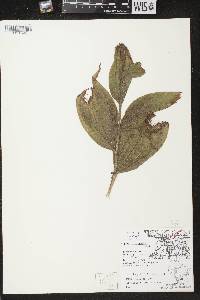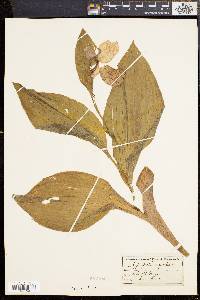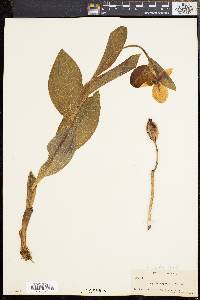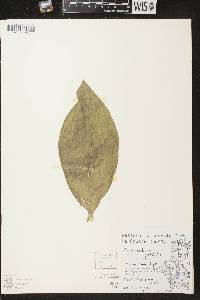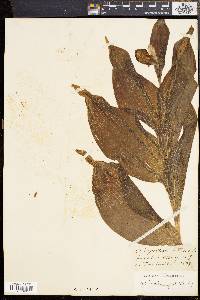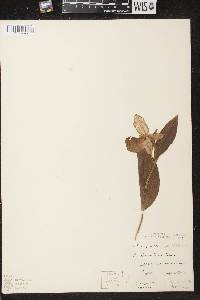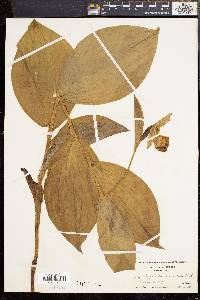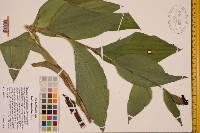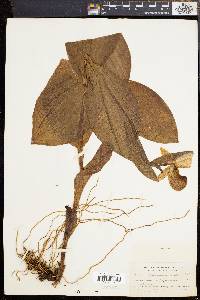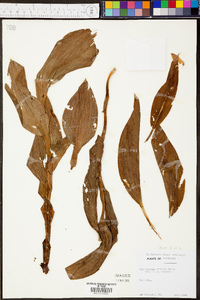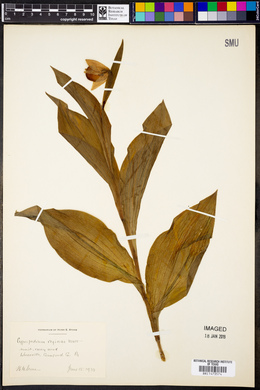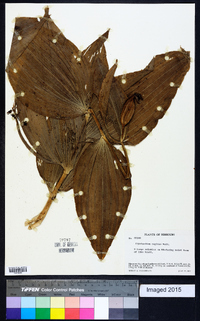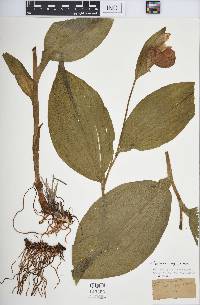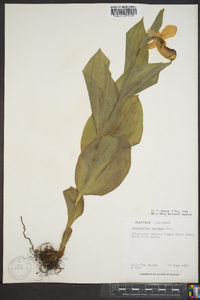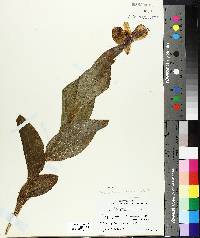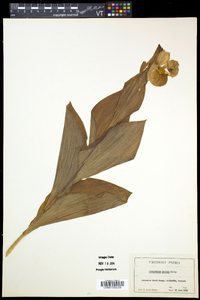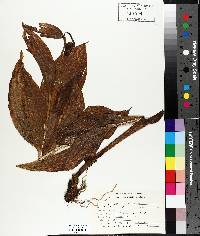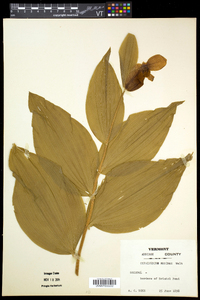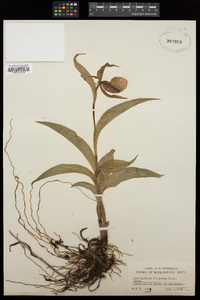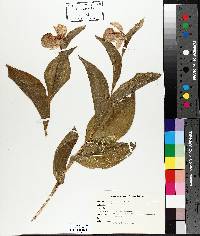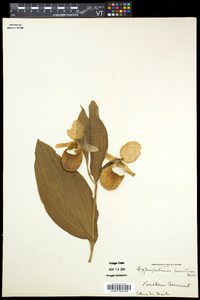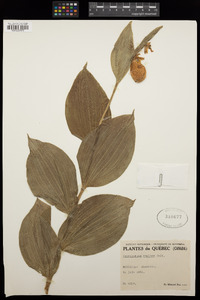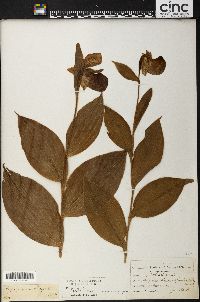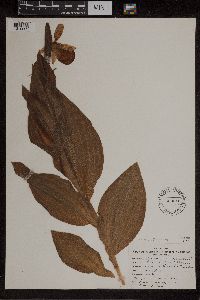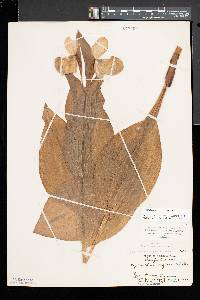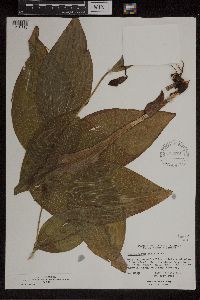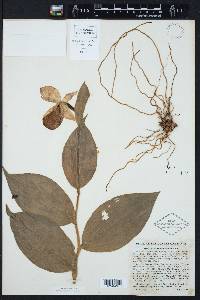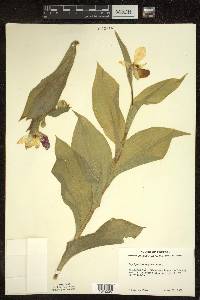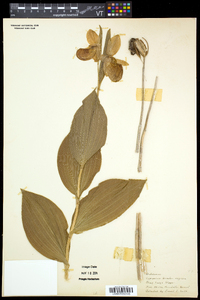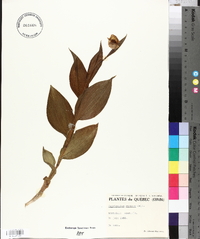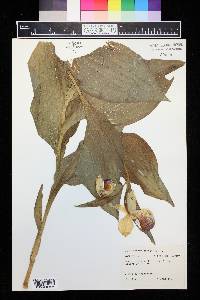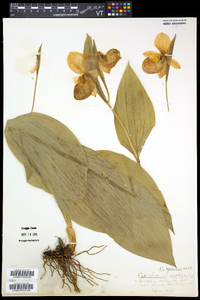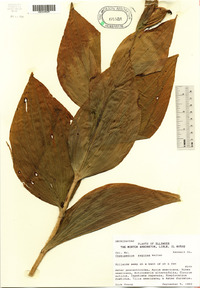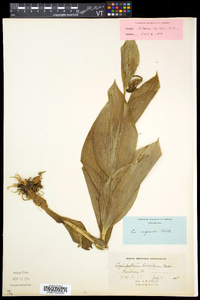
|
|
|
|
Family: Orchidaceae
Showy Lady's-Slipper
[Cypripedium spectabile] |
Plants erect, 21-90 cm. Leaves 3-9, along length of stem, alternate, ascending to spreading; blade broadly elliptic to ovate or elliptic-lanceolate, 10-27 × 5-16 cm. Flowers 1-3(-4); sepals white; dorsal sepal suborbiculate to ovate-orbiculate, 25-45 × 18-42 mm; lateral sepals connate, synsepal 24-42 × 15-37 mm; petals spreading, same color as sepals, oblong to elliptic or ovate-lanceolate, flat, 25-47 × 6-17 mm; lip white, usually suffused around orifice and variably beyond with pale pink to crimson magenta, subglobose-obovoid, 25-53 mm; orifice basal, 18-28 mm; staminode cordiform-ovoid to ovoid-lanceoloid. 2n = 20. Flowering May--Aug. Coniferous and hardwood fen forests, openings, fen meadows, hillside seeps, meadows, prairies, dune lags, seeping cliffs; mostly 0--600 m; Man., N.B., Nfld. and Labr. (Nfld.), N.S., Ont., P.E.I., Que., Sask.; Ark., Conn., Ill., Ind., Iowa, Ky., Maine, Md., Mass., Mich., Minn., Mo., N.H., N.J., N.Y., N.C., N.Dak., Ohio, Pa., Tenn., Vt., Va., W.Va., Wis. Perennial herb 20 - 90 cm tall Stem: one, erect, relatively large (typically over 30 cm), green, leafy, very densely hairy. Leaves: three to eight, alternate, ascending to spreading, stalkless, green, large (10 - 27 cm long, 5 - 16 cm wide), broadly elliptic to egg- or lance-shaped, non-toothed, strongly ribbed, and densely covered with short, stiff hairs. Inflorescence: usually of one or two (can be up to four), erect, terminal, very short-stalked flowers with each flower closely subtended by a stalkless, erect, green, hairy, leaf-like, large, 8 - 10 cm long, 3 - 3.5 cm wide, elliptic to egg- or lance-shaped bract. Flowers: white with pink markings (rarely pure white), showy, large (over 5 cm diameter), hairy, bilaterally symmetric with showy, petal-like upper sepal, two large, showy lateral petals, and a lower, highly modified, very inflated lip petal. Unlike other orchids, the reproductive parts of stamens and stigma are not fused into a column above the inferior ovary, but instead at the basal opening of the lip petal there are two separate anthers, one large, sterile, modified staminode, and a lobed stigma above the inferior ovary. Sepals: petal-like, white to creamy, three, but two lower fused together into a 2.4 - 4.2 cm long, 1.5 - 3.7 cm wide, widely egg-shaped, hairy synsepal positioned behind and below lip petal. The remaining sepal is a bit larger (2.5 - 4.5 cm long, 1.8 - 4.2 cm wide), more rounded, and points upward above the inflated lip petal. Fruit: one or two, stalked, erect, 4 - 6 cm long, widely ellipsoid, hairy capsule with remnant reproductive parts at tip, raised lengthwise ridges, and subtended by remnant hairy bract. Root system: of slender, fleshy, fibrous true roots arising from rhizomes. Lateral petals: two, spreading, white to cream, hairy, 2.5 - 4.7 cm long, 0.6 - 1.7 cm wide, flat (not spirally twisted), oblong to elliptic or egg-lance-shaped. Lip petal: one, central, lowermost, white with prominent pink to purplish marks (especially on top, rarely pure white), 2.5 - 5.3 cm long, about 3 cm wide, greatly inflated, pouch-like, spherical or globose, and hairy. The pink to purplish coloration reaches its darkest shades and is most dense surrounding the 1.8 - 2.8 cm long basal opening of the sac (orifice), thus directing pollinators toward the staminode and reproductive parts behind. Staminode: one, prominent, white with yellow markings and scattered purple spots, heart-shaped to broadly egg-shaped, and positioned below upper sepal and pointing down to basal opening (orifice) of lip. On the back side of the staminode the two anthers are positioned on each side of the central lobed stigma. Similar species: Cypripedium reginae is the largest of our native orchids (typically over 30 cm tall, large flowers with lip over 2.5 cm long and wide), but considering some color variations one could mistake an all white flowered form with C. candidum, but in that species the sepals and lateral petals are not white, or wide and petal-like, but instead are green and narrow, and the lateral petals are spirally twisted. Some may also find C. acaule to be superficially similar, but that species has no leaves along the erect stem, a small bract, dark maroon to brownish sepals and lateral petals, spirally twisted lateral petals, and the lip pouch has a full lengthwise inrolled fold rather than a rounded basal opening (orifice). Flowering: late May to July Habitat and ecology: Very rare now, probably extinct in many areas of the Chicago Region, typically in calcareous fens, swales, swamps, seep springs or occasionally in tamarack bogs. The orchid craves moisture and requires a constant supply of ground water, prefers more neutral to slightly alkaline soils such as black saturated mucks and fen marls, and never tolerates dense shade, but rather loves sun. Occurence in the Chicago region: native Notes: Of all the orchid species in the Chicago Region this species grows the largest and has the largest, most showy flowers. Forms with all white flowers are occasional, and Homoya (1993) discusses an Indiana collection reported by E. J. Hill that was double-flowered, having two petal sacs, one inside the other. Unlike our other species of Cypripedium the showy lady's slipper's primary pollinators include flies and beetles. The hairy leaves and stems in this species are extremely poisonous to some people and produce a reaction similar to severe poison ivy irritation. Still, this has not inhibited people from collecting C. reginae in the wild for the floral trade. Its great beauty and large size have made it often poached, and thus strong conservation efforts are needed. Etymology: Cypripedium comes from combining the Greek word Kypris for Cypris (Aphrodite), the goddess of love and beauty; and either the Latin word pedis meaning foot, or possibly an orthrographic error for the Greek word pedilon meaning sandal or slipper; together translating roughly to beauty's or lady's foot or slipper, in reference to the inflated lip petal resembling a woman's slipper or shoe. Reginae means queen in reference to the majesty of the flowers. Author: The Field Museum Stem leafy, 4-10 dm, hirsute; lvs elliptic-oval, 1-2 dm, half as wide, clasping, strongly ribbed, hairy; fls 1-3; sep white, round-oval, obtuse, 2.5-4 נ1-3 cm, the lower 2 completely united; lateral pet white, flat, oblong, nearly as long as the sep but much narrower; lip 3-4 cm, white or suffused with pink, irregularly streaked with rose or purple outside and marked with purple inside; 2n=20. Swamps, bogs, and wet woods; Nf. and Que. to N.D., s. to N.C., Ga., and Mo. June, July. (C. hirsutum) Gleason, Henry A. & Cronquist, Arthur J. 1991. Manual of vascular plants of northeastern United States and adjacent Canada. lxxv + 910 pp. ©The New York Botanical Garden. All rights reserved. Used by permission. From Flora of Indiana (1940) by Charles C. Deam This orchid was formerly rather frequent in its habitat in our northern counties, but now like the other species of the genus has become rare on account of drainage and grazing. It prefers a wet, cold soil and is usually found in muck in springy places or in peat in tamarack bogs, often in tussocks of sphagnum. In optimum conditions it reaches a height of 3 feet and I once measured a leaf that was nearly 7 inches wide and 1 foot long. I found it to be a common plant in a large springy area at the base of the high bank along Sugar Creek in Montgomery County. R. C. Friesner found a few plants in a marly springy area on the slope of the high bank of Flint Creek about 3 miles northwest of Westpoint, Tippecanoe County and gave me a specimen. It has been reported also from Hamilton, Kosciusko, Marshall, Noble, and St. Joseph Counties. |
|
|
|

